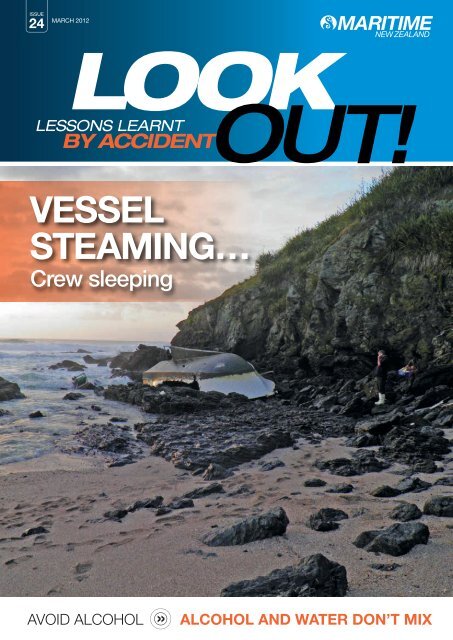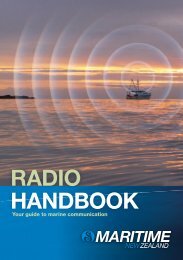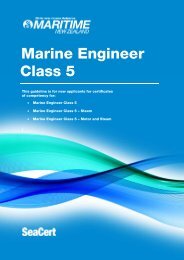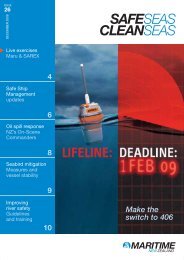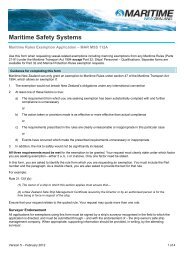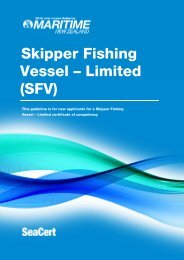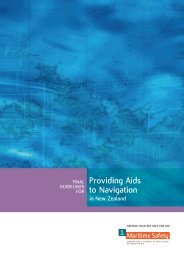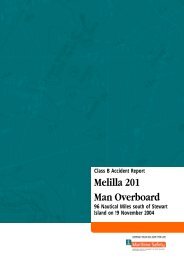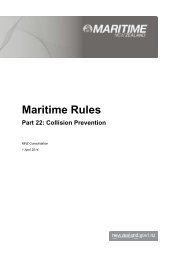Download - Maritime New Zealand
Download - Maritime New Zealand
Download - Maritime New Zealand
- No tags were found...
Create successful ePaper yourself
Turn your PDF publications into a flip-book with our unique Google optimized e-Paper software.
IntroductionKia ora and welcome to the first issue of LOOKOUT! for 2012– my first as Director of <strong>Maritime</strong> <strong>New</strong> <strong>Zealand</strong> (MNZ).This issue looks back at recreational andcommercial accident and fatality statisticsover the past 10 years. Many of theseaccidents and fatalities have been coveredas stories in LOOKOUT! and although weare doing better in some of our key safetyareas, such as the carriage of lifejackets,the statistics show we’ve still got a longway to go.MNZ <strong>Maritime</strong> Safety Inspector AlistairThomson, whose work is focused onrecreational boating, brings us this LOOKOUT!’sguest editorial, with some observations aboutwhat’s been happening out on the water oversummer and with our partners on the NationalPleasure Boat Safety Forum.The cover story, “Vessel steaming … crewsleeping”, shows what can go wrong whengood watchkeeping practices aren’t followed.In this case, the fishing vessel was a total loss,but fortunately all those on board lived to tellthe tale. The skipper, who wasn’t successfullywoken for his turn on watch, had consumedalcohol before departing and failed theyouth alcohol limit when breath-testedafter the grounding.Drinking behaviour on the water is also thesubject of the safety feature, “Alcohol andwater don’t mix”, and is followed by a reviewof some of the alcohol-related accidents fromprevious issues of LOOKOUT! – several ofwhich involve fatalities. “Avoid alcohol” is oneof MNZ’s five key safety messages, but it’s anall-too-common feature of boating accidentsand fatalities.While alcohol wasn’t an issue in the story“No communications, no chance”, two ofour other key safety factors were. Those onboard weren’t wearing lifejackets when theirboat suddenly capsized. They managed torecover some of the lifejackets they carried,but the man who died hadn’t been able toget his lifejacket done up correctly. The groupalso weren’t carrying adequate emergencycommunications that worked when wet, andcouldn’t call for help.Lifejackets and communications were alsofactors in another fatality, when two kayakerswere returning from a day trip to a nearbyisland and got tipped out of their boats. Bothstruggled in the conditions, but only one madeit back to shore to raise the alarm.Accidents involving commercial touristoperations – one jet boating and oneparasailing – also feature, with lessons to belearnt from each.We’ve had some really positive feedback aboutLOOKOUT! from readers, and also throughlast year’s customer satisfaction survey. Wehave shared that with the people who areinvolved in helping put LOOKOUT! together. It’sencouraging to know the safety messages aregetting through.Please pass this LOOKOUT! on to friends,family or crew, and encourage them to sign upto receive print or email copies.Keith ManchDirector of <strong>Maritime</strong> <strong>New</strong> <strong>Zealand</strong>MARITIME NEW ZEALAND LOOKOUT! MARCH 2012 3
GUEST EDITORIALSafety messagesslowly sinking in –but there’s more work to be doneOver summer, boating safetyorganisations have been out andabout, observing behaviour atboat ramps and on the water, handing outinformation, offering advice, and undertakingsurveys to help build a picture of our currentrecreational boating environment.Encouragingly, feedback from the agenciesinvolved – which include MNZ’s network ofvolunteer Safe Boating Advisors, Coastguardvolunteers, regional council harbourmastersand their offi cers, and the Coastguard airpatrol – indicates that, overall, things aregenerally positive.On the plus side, the agencies are reportingthat more boaties are carrying lifejacketsand communications equipment, lifejacketwearing is slowly trending up, and we’re seeingbehavioural change in action.Of more concern, though, is that fatalitiesare still reasonably high – even whenbalanced against an ever-growing increasein boat ownership and activity. There were20 recreational boating fatalities in 2011,compared with 14 in 2010 and 24 in 2009.Already in 2012, there have been three deathsin January alone. If we look back over thepast fi ve years, we’re averaging about17 recreational fatalities per year. While ourrate per 100,000 boats is no worse than someAustralian jurisdictions that have compulsorylicensing, we can do better!Turning to the non-fatal incident reports thatare coming in, we are also observing somecommon trends in the types of incidentsreported … grounding, collision, near miss,too fast, too close and capsize.However, against this background, thereis evidence that people are responding toour safety messages. Here’s one with ahappy ending:“Just left the beach and started trolling-harling,with the rod in the rod holder. I was driftingusing the offshore wind to provide trollingspeed when the rod bent double – I had caughta rock. It was pulled out of the rod holder but Icould see it fl oating so rowed towards it. WhenI got beside the fl oating rod and leaned over topick it up the boat fl ipped and I was suddenlyin the water. Using my waterproof hand-heldVHF radio attached to my lifejacket I sent out amayday call. I was rescued 20 minutes later.”All of this information presents the NationalPleasure Boat Safety Forum (NPBSF) – madeup of 16 water safety organisations that areresponsible for <strong>New</strong> <strong>Zealand</strong>’s Boating SafetyStrategy – with some interesting challenges andopportunities. For example, where and howdo we intervene on the accident continuum toprevent a non-injury near-miss from becomingan injury or collision? Or, worse still, a tragicand avoidable loss of life?This question was being posed long before myarrival at MNZ and I’ve been lucky enough tosit at the forum table where these issues aredebated and recommendations made.<strong>Maritime</strong> Rule 91 made it compulsory forpeople to carry lifejackets, and successivemedia campaigns have nudged the boatingpublic towards carrying and wearing lifejacketsand carrying waterproof communicationsequipment. This is an excellent example of4 LOOKOUT! MARCH 2012MARITIME NEW ZEALAND
Alistair enjoying time out on his boat Lady J.encouraging behaviour change in boaties in anarea of risk that is supported by clear evidence.At the end of the day though, it’s prettysimple – if you fi nd yourself in the water as theresult of an unfortunate set of circumstances,and you can’t fl oat or communicate, then yourchances of coming home alive are fairly limited.It doesn’t take a massive change in behaviourto give you (and your nearest and dearest) thebest possible chance of coming home in onepiece. It’s about basic risk management.In line with its evidence-based approachto boating safety, the forum recentlycommissioned some research into boatingbehaviours and attitudes towards lifejacketsand safety equipment for males over 40, whoare over-represented in fatality statistics. Theresults were revealing.The research told us that when we go boatingit’s about shared experiences, conviviality,thinking with the heart and enjoying life. Whenthe research subjects were asked aboutsafety and lifejackets, themes like control andsecurity were evident. Lifejackets and safetyequipment were about thinking with the headand fearing the worst. The ongoing challengefor groups like the forum is to fi nd a way tomake lifejackets and safety equipment part ofthe ‘culture’ of boating, in the same way thatputting on your seatbelt or maintaining a safespeed are accepted parts of driving onthe road.By now many of you will have seen our latesttelevision commercial “Don’t be a clown. Weara lifejacket.” The commercial uses humourto encourage skippers and crew to takeresponsibility for safety. We’ve had plenty ofpositive feedback about the commercial andeven when the feedback has been less positive,it shows that people are talking about thelifejacket issue.The forum’s Boating Safety Strategy is comingup for review this year, a process that willanalyse the 83 recreational boating fatalitiesthat have occurred since 2007. This will providethe opportunity to review again the commoncausal factors involved in boating accidentsand fatalities – which previously have includedlack of lifejackets, inability to communicatedistress, boating in bad weather and excessivealcohol consumption.for licensing in particular appears attractive,the solution to actually reducing accidents andfatalities is far more simple. For example, ifmore people followed a few basic seamanshipprinciples, such as wearing lifejackets andkeeping a good lookout, we’d probably halvethe number of recreational fatalities almoststraight away.It is against this background that the membersof the forum are always looking for ways towork together better, to be more effi cient andto spend the limited funding we have moreeffectively.Through a mix of education, legislation andtargeted enforcement, we’re making gainsin a number of areas, with forum memberorganisations committed to helping reducerecreational boating accidents and fatalities.Organisations like the Coastguard BoatingEducation Service and Yachting <strong>New</strong> <strong>Zealand</strong>,for example, are delivering a range of excellentpractical and theory-based courses to<strong>New</strong> <strong>Zealand</strong> boaties, and are always lookingat ways to get greater participation in boatingeducation.Regional council harbourmasters areundertaking education and enforcement actionout on the water. We’ve seen a signifi cantincrease in enforcement action this summer –an essential tool for promoting better behaviour.Water Safety <strong>New</strong> <strong>Zealand</strong> has incorporatedagreed sector-wide integrated messaginginto its regional workshops and its nationwideswim-to-survive programmes, as well as itsvery successful Màori, Asian and Pacifi c Islandwater safety strategies.The Accident Compensation Corporationhas delivered award-winning boating safetyprogrammes into Polynesian communitiesin Auckland, followed by expansion into theWellington region.And Coastguard <strong>New</strong> <strong>Zealand</strong>, one of the mostvisible organisations out on the water, is leadingby example and responding to calls for helpand communicating the safe boating messageat every opportunity.I’m sure I’m not alone in saying that amajor contributing factor to seeing a furtherreduction in accidents and fatalities, will beif all organisations keep ‘steering the boat inthe same direction’ and communicate theintegrated safety messages. We all know them:be a responsible skipper, wear lifejackets, carrycommunications equipment, check the marineweather and avoid alcohol.Alistair Thomson is a <strong>Maritime</strong> SafetyInspector (MSI) based in MNZ’s Aucklandoffi ce. His time is predominantly dedicatedto recreational boating safety promotion,but he undertakes commercial vesselinspections from time to time. He is a keenrecreational boatie, has a young familyand lives in East Auckland. You can phoneAlistair on (09) 307 1370 or emailalistair.thomson@maritimenz.govt.nzThe forum also routinely reviews the issue oflicensing and registration of recreational boatiesand boats. While on the face of it, the argumentSafe Boating Advisor Katie McNabb hands a recreational boatie some safety material.MARITIME NEW ZEALAND LOOKOUT! MARCH 2012 5
No communications,no chanceSearchers, including personnel from the Navy, Police and Coastguard, look for a man missing after the boat he and four others were in, sank.Photo: The <strong>New</strong> <strong>Zealand</strong> HeraldFour men and a 13-year-old boystruggled against cold, choppy seas toreach shore after their boat capsized.As they fought for their lives, no one on shorehad any inkling that they were in danger andtheir attempts to raise the alarm failed.The group had set out for an afternoon’sfi shing, in an aluminium boat. No one wore alifejacket, although there were six carried onboard. The boat was travelling at speed, andup on the plane when the motor suddenlystopped. As the boat dropped off, its wakefl ooded over the starboard quarter, causing it toroll to starboard and capsize. All fi ve on boardwere spilled into the sea.The capsize was totally unexpected. The mentried unsuccessfully to right the hull, and tomake a 111 cellphone call, but could not getthrough due to poor coverage.They managed to set off a smoke fl are, butpeople on a nearby yacht did not appear to seeit, and others on shore who saw it did not raisethe alarm. One of the men sent his partner atext message, but she didn’t take it seriously.One of the men managed to dive under theboat and pull out three lifejackets, which weredivvied out to those who needed them most.The group decided to try to make shore, andstarted swimming towards a group of islandsabout 2 kilometres away.By now the wind had picked up and a slightchop had developed. The party was separatedinto two groups, who were soon unable to seeeach other in the choppy conditions.The two groups continued their struggletowards the islands for about three hours.One man towed his companion as besthe could for some way, but eventually thecompanion was lost. The man managed toreach one of the islands, and spent a freezingwet night alone, thinking he was the only onewho had survived.The next morning he saw that the boy andthe other two men had made it to an adjacentisland, and at low tide he was able to pick hisway over a reef to join them.About mid-morning, the wife of one of themen started to think something was wrongand raised the alarm. The group were foundby a rescue helicopter soon after. Theywere extremely hypothermic, but eventuallyrecovered in hospital.An extensive air and sea search failed to fi ndthe missing man. His body was recoveredsome days later.8 LOOKOUT! MARCH 2012MARITIME NEW ZEALAND
MNZ recommends carrying two waterproof means of calling for help.The men carried, but did not wear, lifejackets on their aluminium boat, pictured above.LOOKOUT! POINTS• The men were not wearing lifejackets, andthe boat capsized so quickly that they did nothave time to put them on before being throwninto the sea. Three lifejackets were recovered,but these were diffi cult to put on once the menwere in the water. The man who drowned hadnot done up the waist strap on his lifejacket,and it had slipped off.• None of the party had made a clear planwith anyone on shore about what time theyshould be expected to return. The partners oftwo of the men had simply assumed the menhad decided to stay at each other’s housesovernight, and were not at all concerned untilthe morning. Letting someone responsibleknow where you’re going and when you intendto be back will mean that action is taken if youare overdue.• The men had few ways to raise the alarm.There was poor cellphone coverage, and theydid not carry a waterproof, hand-held VHFradio. One of the men sent a text message tohis partner as soon as he was fl ung into thewater, but it was not taken seriously.• The men fi red a fl are, which had been seenfrom shore, but no one took any action. All fl aresightings should be responded to as thoughthey indicate a real emergency. It is far betterto raise the alarm, even if this turns out to be inerror. It is not known whether those on boardthe nearby yacht also saw the men’s fl are.• The boat had a boarding platform thatextended aft of the hull from the bottom ofthe transom. When brought to a sudden stop,most vessels like this will be impacted bytheir own wake on the transom. In this case,the boarding platform may also have dug thestern into the water, providing an easy path forthe water to fl ow into the vessel. The fl oodingwaters then quickly capsized it.• This tragedy highlights the importance ofpreparing for a sudden emergency. In manycases, there is no time to put on lifejackets orgrab emergency communications equipment.MNZ recommends wearing lifejackets at alltimes and carrying two effective means ofcommunication that will work when wet.A distress beacon or waterproof handheldVHF carried in a pocket or fl oat-free grabbag would have enabled the men to alertemergency services.MARITIME NEW ZEALAND LOOKOUT! MARCH 2012 9
SAFETY FEATUREAlcohol and water don’t mixBOATING AND ALCOHOLCAN BE A DEADLYCOMBINATIONAlcohol, even in small quantities, affects yourcoordination and judgement, and exaggeratesconfi dence. It can also reduce your ability toperform tasks, impair your sense of direction,and cause unsteadiness.Alcohol also affects your ability to react whensomething goes wrong, and its effects areexaggerated on and in the water.Consumption of alcohol may:• impair your ability to react if somethinggoes wrong• increase the likelihood of you ending up inthe water by accident• change the way your body reacts when youenter the water• decrease your body’s ability to respondeffectively once you are in the water,through confusion and lack of coordination.IT DOESN’T TAKE MUCHALCOHOL OR TIME…Alcohol is absorbed directly into the bloodstream and its effects are usually apparentwithin minutes. Even moderate drinking canseriously impair your ability to operate aboat safely.Drinking alcohol faster than your body canprocess it will increase blood alcohol levels.Alcohol is burned off at a fairly constantrate – at about one standard drink per hour.Consumption of any amount of alcohol may bedangerous, but the higher the resulting bloodalcohol level, the greater the danger. Alcoholaffects people differently and reactions willvary, depending on factors such as the type ofalcohol you have consumed, and your bodyweight, food consumption, medication, stressand fatigue.No matter what the activity, alcohol affectsbalance, vision, coordination and judgement.In boating, factors like wind, sun, noise, motionand vibration can magnify the effects of alcoholand accelerate impairment.A momentary lapse that might pass unnoticedon shore can have dangerous consequencesout on the water.YOU’RE THE SKIPPER,YOU’RE RESPONSIBLEAs a skipper, you’re responsible for the safetyand wellbeing of everyone on board your boat.A responsible skipper will never operate underthe infl uence of alcohol or allow an intoxicatedperson to operate their boat.Operating a boat is at least as complicated asdriving a car, and a boating accident can bejust as lethal as a road accident. Many peoplewho would never drive drunk think it’s safe tooperate their boat after drinking. It isn’t.You can be prosecuted for operating aboat in a manner that causes unnecessarydanger, under section 65 of the <strong>Maritime</strong>Transport Act.Avoid or limit alcohol – moderation andcommon sense should dictate how muchalcohol is consumed on your boat. Limitconsumption to one standard drink (or less) perhour. It’s better to wait until you’re anchored forthe day before enjoying alcoholic beverageson board, and even then, you should limitintake. The best policy is to wait until you’reon dry land.IF YOU’RE ON BOARD,YOU NEED TO BEPREPAREDIf you’re on board a boat and intoxicated, youare a danger to yourself and put others atrisk. Parents supervising children need to beparticularly alert while on the water.If you end up in the water…If you’ve been drinking, the risks escalategreatly the moment you end up in the water.Alcohol will:• decrease your coordination and ability toperform a simple task, such as putting ona lifejacket• increase your sense of disorientation• make it harder for you to stay afl oat• lower concentrations of blood going to yourbrain and muscles, contributing to muscle,heat and fl uid loss• reduce your ability to hold your breath• suppress your airway protection refl exesand make it easier for you to inhale water• give you a false sense of your situation,causing you to attempt tasks beyondyour abilities• reduce your awareness of the onsetof hypothermia.MAKE SURE YOU DON’TGO OVERBOARD IFYOU’RE TAKING A LEAKThere have been a number of cases in recentyears where experienced mariners have fallenoverboard while urinating off the side anddrowned (especially at night). Be careful whereand how you go.THERE’S NO SUCHTHING AS ‘OFF THECLOCK’ ON A BOATOR SHIPMariners on board a vessel should always becapable of performing any tasks required ofthem. This is particularly important on a ship,where an emergency requiring action by thecrew may arise at any time.Avoid alcohol10 LOOKOUT! MARCH 2012MARITIME NEW ZEALAND
ISSUEDespite extensive on-water and shorelinesearches, the man’s body was not recovered.Photos: Stuff.co.nzLOOKOUT! POINTSExhaustedkayaker drowns• Neither kayaker wore a lifejacket. Theylooked for some before leaving home, butwhen they couldn’t fi nd any, they set offanyway. A lifejacket would have enabledthe kayakers to remain afl oat in the waterwithout expending a large amount of energy,and would have reduced the tendencyto panic.• Lifejackets also increase a person’s abilityto survive in cold water. A type 401 lifejacketis designed to hold an unconscious person’shead and face clear of the water.Akayaker struggled in vain to reach hercompanion after he was tipped out ofhis kayak by a wave.The pair had only minimal kayaking experience,but both were confi dent on the water. Theyhad decided to take a kayak trip to a nearbyisland for a picnic lunch. The trip took about40 minutes, and once at the island, the pairspent another hour having lunch and restingbefore setting off for home.On the way back, the wind had picked upand the going was tougher. About halfway toshore one kayaker fell out and cried out to hercompanion, who was about 20 metres ahead.As he turned towards her, he was also tippedout by a wave.Once in the water, the man let go of his kayakto pull off his backpack. Immediately, the kayakdrifted away out of reach. His companion wasstill in the water and started swimming towardshim, towing her kayak behind her.After about 15 minutes, she still had notreached him and climbed back into her kayak.When she leaned over to pick her paddle upout of the water, she fell back into the sea andagain tried swimming towards her friend, withthe kayak in tow.About 15 minutes later, the pair were still somemetres apart. The woman climbed back onboard her kayak and started sculling with herhands to try to reach her friend, who was bynow tiring with the effort of remaining afl oat.He was calling out and raising his hand up inthe air to let her know where he was, but astime passed he grew more and more frantic,going under the water frequently.About 10 minutes later, his calls had stoppedand the kayaker could no longer see her friend.She remained in the area for some time beforedeciding to try to make it back to shore.Sculling with only her hands and strugglingagainst the waves, she eventually reachedshore and raised the alarm.An extensive sea and air search over twodays failed to fi nd the missing kayaker. Hiskayak eventually washed up on shore, andhis backpack and paddle were pulled outof the water.• The pair were not equipped with anymeans of communication, and had noway of raising the alarm. At a minimum, acellphone in a sealed plastic bag, carried in apocket, would have enabled them to call forhelp from the water. It is recommended thatpeople carry two means of signalling distressthat will work when wet.• The planned voyage would havebeen suitable for novices only in perfectconditions. On the day of the trip it waswindy, and so conditions worsenedconsiderably once the kayakers movedbeyond the more sheltered inner waters.See the “Paddlesafely” kayakingsafety featurein the December2011 issue ofLOOKOUT!for more info.PADDLE SAFELY23»DECEMBER 2011KEEP RIGHTBoth up & down streamKEEP SAFE AND HAVE FUN ON YOUR KAYAKMARITIME NEW ZEALAND LOOKOUT! MARCH 2012 13
Spinning outof controlA parasailing boat capsized and the crew and passengers were recovered from the water by the boat’s owner who had seen the accident from anothervessel onshore. Photo: Daily PostTwo women clung to theirtandem parasail as it spunaround in circles whilestill tethered to theparasailing boat.The women were launched together for atethered parasail fl ight from a purposebuiltparasailing boat. In a parasailingfl ight, the parasail is released into the air anddrawn back in to the boat by winch. The ideawas fi rst developed by the German navy in1918 to tow sailors behind U-boatsas observers.The parasail carrying the two women had beenwinched into the air, and was being towedalong at about 5 knots. When the boat wasabout 500 metres from shore, the parasailsuddenly started to spin in circles and wasblown hard out to the port side of the boat,which immediately capsized.The skipper, winchman and three passengerson the boat – including a fi ve-year-old boy –were thrown into the lake. They were at risk ofbeing struck by the still-spinning propellers untilthe skipper managed to dive underneath thecapsized vessel and stop the outboard motors.Meanwhile, the parasail had stabilised, and washanging in mid-air, still tethered to the capsizedparasailing boat with both women entangled,but still in their harness.The owner of the company was loadingpassengers onto another vessel from theshore when he looked up to see a trail ofsmoke rising from the distant parasailing boat.He immediately unloaded the passengersand sped to the scene.The crew and passengers were recovered fromthe water and the towline to the parasail wascut free. The parasail descended into the lakeand the two women were recovered unharmed.The parasailing company immediatelysuspended its operations.“When the boat wasabout 500 metres fromshore, the parasailsuddenly started tospin in circles andwas blown hardout to the port sideof the boat, whichimmediately capsized.”14 LOOKOUT! MARCH 2012MARITIME NEW ZEALAND
LOOKOUT!POINTS• The parasail had an airspeed limit of22 knots, and an optimum speed of 14knots. At the time of the incident, the windsreached 24 knots, and the vessel wasmaking 5 knots. This gave a combinedairspeed of 29 knots, exceeding theparasail’s limit.Excessive airspeed tends to overpower aparasail, forcing it to spill the excess air outto one side or the other. The result is anout-of-control spin. As the parasail was stillattached to the vessel, its sudden spin andlurch to the port side almost certainly causedthe vessel to capsize.The women remained in the air for about10 minutes before being lowered down.They had no injuries.• The operator of this business wasa newcomer to the field, which is onlyinformally regulated. He had undergonea total of three days observation of otherparasailing businesses in <strong>New</strong> <strong>Zealand</strong> andAustralia before setting himself up to carryfare-paying passengers. He also trained hisown staff, a decision which one experiencedoperator described as the ‘blind leadingthe blind’.As a guide, the <strong>New</strong> <strong>Zealand</strong> ParasailAssociation’s Rules and Standardsrecommend a minimum of two experiencedcrew, including a skipper with a minimumof 500 hours or 1,000 flights of loggedparasailing operating experience, anda first mate with 25 hours of experience.That experience must be logged in thelocation where the flights are to takeplace, under the direct supervision ofa qualified parasailer.The skipper in this case held a locallaunchmaster qualification and was also ahelicopter pilot. His parasailing experienceconsisted of only 100 hours training with theoperator, who was himself inexperienced.Parasailing is a specialised industry.Experience in related fields is not enough.• The operator has since moved the winchand towing points on the parasailing boat,lowered the deck and moved the steeringhelm from the centre to one side. He hasalso purchased an adjustable chute and seta passenger weight limit, with no doubleadult tandems until the crew are moreexperienced.• The parasailing industry, with assistancefrom MNZ, has been working to developrobust safety guidelines. These will berecommendatory material under the Healthand Safety in Employment Act, and willinclude training requirements for the skipperand deckhand. Other requirements, underthe <strong>Maritime</strong> Transport Act, are for skippersto have the entry-level local launch operator(LLO) qualification and for the vessel to bein safe ship management.maritimenz.govt.nz/lifejacketsMARITIME NEW ZEALAND LOOKOUT! MARCH 2012 15
MARITIME FATALITY ANDTotal recreational fatalitiesfor the period 2002–2011 arealmost two and a half timesthe total for commercialfatalities (161 recreationalfatalities, compared with66 commercial fatalities).The recreational fleet,however, at around500,000 vessels is morethan 100 times bigger thanthe commercial fleet ofabout 4,400 vessels.252015105Recreational and commercial maritime fatalitiesRecreationalCommercialThere were 20 recreational fatalities in 2011,the third-highest number of fatalities in the past10 years, with 24 recorded in 2009 and 21 in2002. The lowest number of fatalities for theperiod, seven, was recorded in 2006.For each of the past fi ve years, at least threerecreational fatalities have involved dinghies.In 2009, there were nine recreational fatalitiesinvolving dinghies. There were four kayakfatalities in both 2011 and 2010 and six trailerpowerboat fatalities in 2011.0765432002 2003 2004 2005 2006 2007Commercial fatalities by vessel type200820092010201120072008200920102011In the decade 2002–2011, annual fatalities inthe commercial sector ranged between threeand 11. Neither the fatality rate nor the accidentrate in the commercial sector has shown anyconsistent improvement in the period.210foreign SOLASpassengernon-passengerfishingraftjet boatriverboardIn the commercial sector, there has been atleast one fatality in the fi shing and foreignSOLAS categories in each of the past fi veyears. However, the total number of fatalitiesfor the fi shing sector (12) is double that for theforeign SOLAS category over the period.1098Recreational fatalities by vessel type2007200820097201062011543210dinghykayakmotor launchtrailer powerboattrailer yachtkeel yachtjet boattrimaranCanadian canoeoutrigger canoeraftjet skiwindsurferotherunknown18 LOOKOUT! MARCH 2012MARITIME NEW ZEALAND
ACCIDENT STATISTICSCommercial serious harm injuries by vessel type30252015200720082009201020111050foreign SOLASNZ SOLASpassengernon-passengerfishingjet boatraftpaddle craftSerious harm by commercial vessel type, 2011otherraftpassengerNZ passenger (SSM)NZ non-passenger (SSM)NZ fishing (SSM)NZ cargo (NZISM)non-passengerjet boatforeign SOLAS (ISM)fishingforeign charter fishing1112257891416200510152025Serious harm by recreational vessel type, 2011dinghyyacht (sail)11trailer powerboat4RIBPWC11powerboat/jet boat8jet boat6012345678 9MARITIME NEW ZEALAND LOOKOUT! MARCH 2012 19
<strong>New</strong>s & updates<strong>New</strong>-look website coming soonWe’ve been working on a new design for theMNZ website, which we aim to roll out laterthis year. Landing and information pages willbe fi ne-tuned to suit more of our growingtarget audiences, and the different layers ofinformation that sit under these will be easierto navigate. Alongside the new design will be abetter search function, so you’ll be able to fi ndwhat you’re looking for more easily.There will also be a media centre, so whenthere’s a major incident or search and rescue,information about the incident, images andrelevant background information and statisticswill be easy to fi nd and in one place. The majorincident mode that we’ve been using for thepast two years will still feature. This has beenused very successfully during theRena grounding.Down the track, we’ll be adding more onlineservices and looking at which services we canoffer in a format tailored for mobile phone use.Online accident reporting, media releases andsafety updates will be fi rst in line for mobiletreatment.23<strong>Maritime</strong> fatalities 2011From 1 January to 31 December 2011 there were 23 fatalities –3 in the commercial sector and 20 in the recreational sector.This compares with 9 commercial and 14 recreational fatalities in 2010.FREE subscription to LOOKOUT! and Safe Seas Clean SeasTo subscribe or unsubscribe to these FREE quarterly publications, or to change youraddress details, email us at publications@maritimenz.govt.nz or phone 0508 22 55 22.LEVEL 10, OPTIMATION HOUSE1 GREY STREET, PO BOX 27006WELLINGTON 6141, <strong>New</strong> <strong>Zealand</strong>TELEPHONE +64 4 473 0111FACSIMILE +64 4 494 1263WWW.MARITIMENZ.GOVT.NZDisclaimer: While all care and diligence has been used in extracting,analysing and compiling this information, <strong>Maritime</strong> <strong>New</strong> <strong>Zealand</strong> gives nowarranty that the information provided is without error.Copyright <strong>Maritime</strong> <strong>New</strong> <strong>Zealand</strong> 2012: Parts of this document may be reproduced,provided acknowledgement is made to this publication and <strong>Maritime</strong> <strong>New</strong> <strong>Zealand</strong>as the source. Products shown in LOOKOUT! as part of our education messagesare examples only, and are not necessarily favoured over any other similar product.ISSN: 1177-2654


